Jeremy Michalek
@jmichalek.bsky.social
Professor at Carnegie Mellon in Engineering & Public Policy, Mechanical Engineering and Civil & Environmental Engineering.
Director of the Vehicle Electrification Group.
#EVs 🔌🚗, #EnergySky 🔌💡, #GreenSky
Director of the Vehicle Electrification Group.
#EVs 🔌🚗, #EnergySky 🔌💡, #GreenSky
EPA's proposal: www.epa.gov/regulations-...
Our comment: www.cmu.edu/cit/veg/publ...
Brief summary: www.cmu.edu/cit/veg/publ...
w/ @paulijllo.bsky.social @costasamaras.com et al.
Our comment: www.cmu.edu/cit/veg/publ...
Brief summary: www.cmu.edu/cit/veg/publ...
w/ @paulijllo.bsky.social @costasamaras.com et al.

September 22, 2025 at 8:42 PM
EPA's proposal: www.epa.gov/regulations-...
Our comment: www.cmu.edu/cit/veg/publ...
Brief summary: www.cmu.edu/cit/veg/publ...
w/ @paulijllo.bsky.social @costasamaras.com et al.
Our comment: www.cmu.edu/cit/veg/publ...
Brief summary: www.cmu.edu/cit/veg/publ...
w/ @paulijllo.bsky.social @costasamaras.com et al.
Today we submitted our public comment on critical flaws in EPA's rationale for rescinding its authority to regulate greenhouse gas emissions.
This proposed move is a big deal with profound implications for our future. Today's the last day to comment. www.cmu.edu/cit/veg/publ...
This proposed move is a big deal with profound implications for our future. Today's the last day to comment. www.cmu.edu/cit/veg/publ...
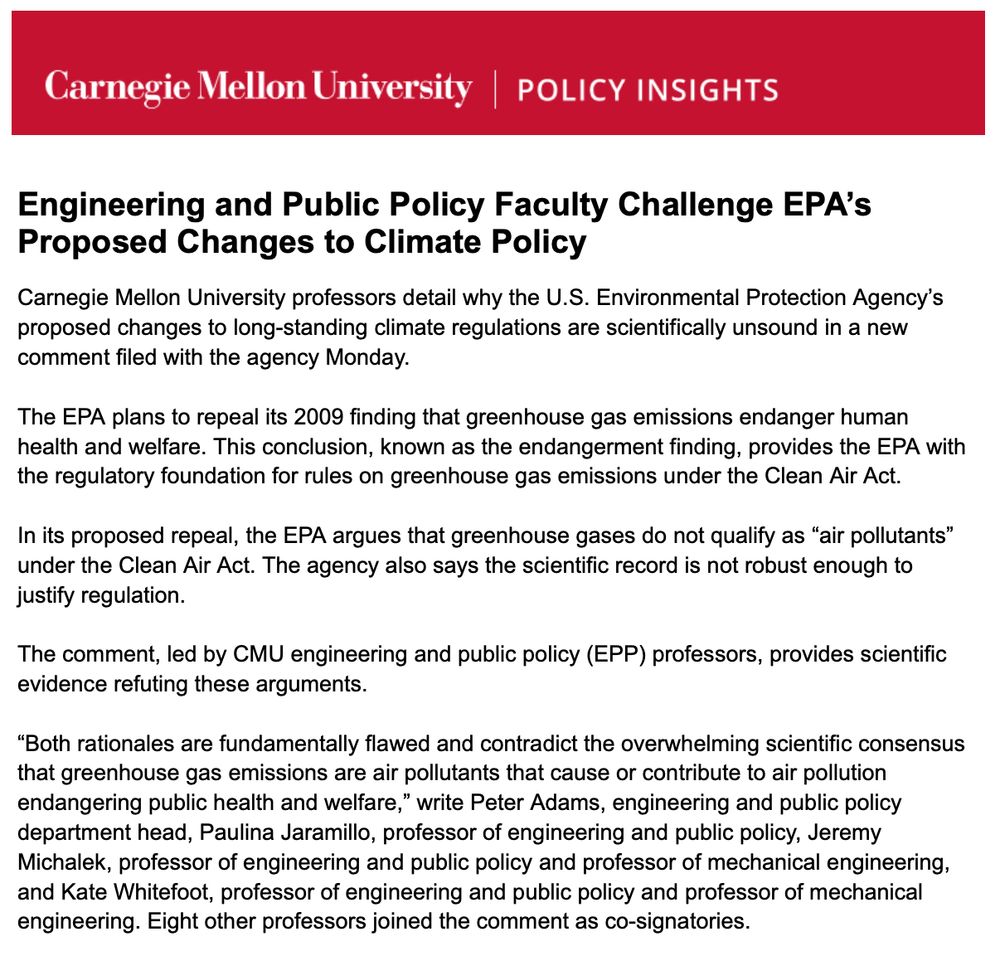
September 22, 2025 at 8:42 PM
Today we submitted our public comment on critical flaws in EPA's rationale for rescinding its authority to regulate greenhouse gas emissions.
This proposed move is a big deal with profound implications for our future. Today's the last day to comment. www.cmu.edu/cit/veg/publ...
This proposed move is a big deal with profound implications for our future. Today's the last day to comment. www.cmu.edu/cit/veg/publ...
Still, if I were going to fast charge a lot, I'd prefer LFP.
LFP tends to be used on the lower-range EVs, which are the ones we need to fast charge more often (bonus!).
If I were buying a used EV, I'd also feel batter about an "iron-clad" LFP battery. It keeps going and going and going...
LFP tends to be used on the lower-range EVs, which are the ones we need to fast charge more often (bonus!).
If I were buying a used EV, I'd also feel batter about an "iron-clad" LFP battery. It keeps going and going and going...

June 12, 2025 at 8:51 PM
Still, if I were going to fast charge a lot, I'd prefer LFP.
LFP tends to be used on the lower-range EVs, which are the ones we need to fast charge more often (bonus!).
If I were buying a used EV, I'd also feel batter about an "iron-clad" LFP battery. It keeps going and going and going...
LFP tends to be used on the lower-range EVs, which are the ones we need to fast charge more often (bonus!).
If I were buying a used EV, I'd also feel batter about an "iron-clad" LFP battery. It keeps going and going and going...
LFP is cheaper and relies on fewer critical materials (www.nature.com/articles/s41...). Its main disadvantage is lower energy density (shorter range). But since LFP can take so much more abuse, more of its capacity can be used in practice, reducing or eliminating its key weakness

June 12, 2025 at 8:51 PM
LFP is cheaper and relies on fewer critical materials (www.nature.com/articles/s41...). Its main disadvantage is lower energy density (shorter range). But since LFP can take so much more abuse, more of its capacity can be used in practice, reducing or eliminating its key weakness
Replacing the battery every time it died would be prohibitively expensive in the extreme cases

June 12, 2025 at 8:51 PM
Replacing the battery every time it died would be prohibitively expensive in the extreme cases
Restricting the portion of the battery's capacity that the vehicle can use (as automakers do) can make NMC and NCA batteries last longer, at the cost of reduced range
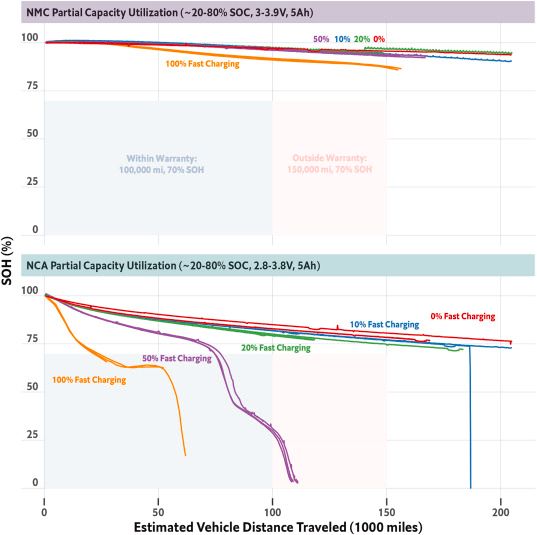
June 12, 2025 at 8:51 PM
Restricting the portion of the battery's capacity that the vehicle can use (as automakers do) can make NMC and NCA batteries last longer, at the cost of reduced range
When we used the entire battery capacity
- Fast charging killed NCA batteries (bottom, used in long range Teslas) rapidly.
- Heavy fast charging also killed NMC batteries (middle, used by most US automakers).
- LFP batteries (top, used in standard range Teslas) can take the abuse.
- Fast charging killed NCA batteries (bottom, used in long range Teslas) rapidly.
- Heavy fast charging also killed NMC batteries (middle, used by most US automakers).
- LFP batteries (top, used in standard range Teslas) can take the abuse.

June 12, 2025 at 8:51 PM
When we used the entire battery capacity
- Fast charging killed NCA batteries (bottom, used in long range Teslas) rapidly.
- Heavy fast charging also killed NMC batteries (middle, used by most US automakers).
- LFP batteries (top, used in standard range Teslas) can take the abuse.
- Fast charging killed NCA batteries (bottom, used in long range Teslas) rapidly.
- Heavy fast charging also killed NMC batteries (middle, used by most US automakers).
- LFP batteries (top, used in standard range Teslas) can take the abuse.
We cycled NMC, NCA and LFP batteries (the 3 types used in today's EVs) with varying amounts of slow charging (e.g. at home, level 2) and fast charging (e.g. highway rest stop, DCFC).
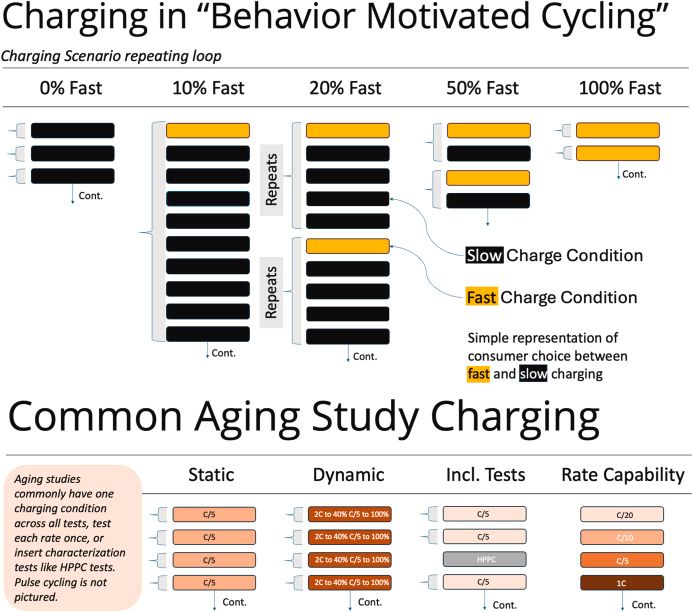
June 12, 2025 at 8:51 PM
We cycled NMC, NCA and LFP batteries (the 3 types used in today's EVs) with varying amounts of slow charging (e.g. at home, level 2) and fast charging (e.g. highway rest stop, DCFC).
TNCs generally increase VMT relative to personal vehicle travel unless (1) more rides are pooled or (2) personal vehicle travel requires *very* extensive search for parking.
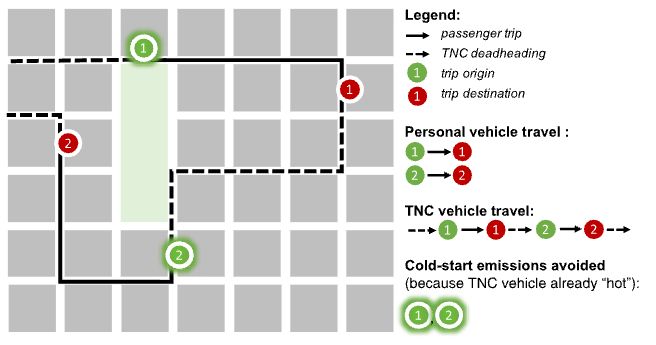
June 12, 2025 at 7:39 PM
TNCs generally increase VMT relative to personal vehicle travel unless (1) more rides are pooled or (2) personal vehicle travel requires *very* extensive search for parking.
We don't have exactly that comparison in the study, but broadly TNC electrification addresses a smaller portion of externality costs than VMT reduction (because of congestion and collision costs).
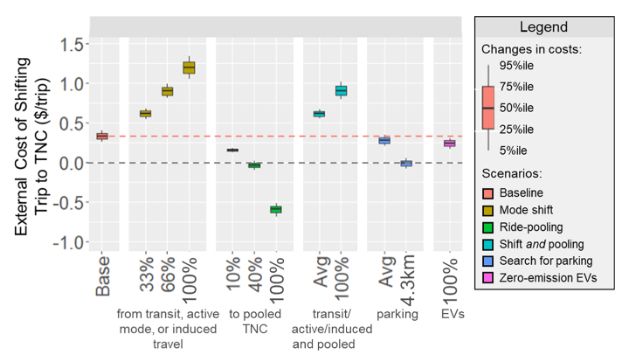
June 12, 2025 at 7:37 PM
We don't have exactly that comparison in the study, but broadly TNC electrification addresses a smaller portion of externality costs than VMT reduction (because of congestion and collision costs).
New CMU/ANL study on incorporating energy justice and equity objectives in power system models takes a broad look at practices and opportunities across the literature

December 16, 2024 at 2:49 PM
New CMU/ANL study on incorporating energy justice and equity objectives in power system models takes a broad look at practices and opportunities across the literature
Carnegie Mellon University
ranked #1 for #AI
has a faculty opening in AI & Policy.
Lots to do in this space. Join us!
apply.interfolio.com/154855
www.usnews.com/best-graduat...
#Hiring #Faculty #EngineeringJobs #AI #Policy #ArtificialIntelligence #CMU
ranked #1 for #AI
has a faculty opening in AI & Policy.
Lots to do in this space. Join us!
apply.interfolio.com/154855
www.usnews.com/best-graduat...
#Hiring #Faculty #EngineeringJobs #AI #Policy #ArtificialIntelligence #CMU

October 21, 2024 at 3:13 PM
Carnegie Mellon University
ranked #1 for #AI
has a faculty opening in AI & Policy.
Lots to do in this space. Join us!
apply.interfolio.com/154855
www.usnews.com/best-graduat...
#Hiring #Faculty #EngineeringJobs #AI #Policy #ArtificialIntelligence #CMU
ranked #1 for #AI
has a faculty opening in AI & Policy.
Lots to do in this space. Join us!
apply.interfolio.com/154855
www.usnews.com/best-graduat...
#Hiring #Faculty #EngineeringJobs #AI #Policy #ArtificialIntelligence #CMU
I swore that article had this figure in it

October 8, 2024 at 12:38 PM
I swore that article had this figure in it
Prices of EV critical minerals (particularly lithium) are constantly changing, so we explore the impact of material prices in the second panel in our tool – with implications for 30D credit qualification.
acheng98.shinyapps.io/IRAMineralPr...
🧵10/14
acheng98.shinyapps.io/IRAMineralPr...
🧵10/14

October 2, 2024 at 1:37 PM
Prices of EV critical minerals (particularly lithium) are constantly changing, so we explore the impact of material prices in the second panel in our tool – with implications for 30D credit qualification.
acheng98.shinyapps.io/IRAMineralPr...
🧵10/14
acheng98.shinyapps.io/IRAMineralPr...
🧵10/14
Does my #EV qualify?
With these varying chemistries, supply chains, and caveats, it may be confusing to understand the relative effect of these incentives.
Try our tool to see how the incentives stack up across different EVs and scenarios!
acheng98.shinyapps.io/IRAMineralPr...
🧵9/14
With these varying chemistries, supply chains, and caveats, it may be confusing to understand the relative effect of these incentives.
Try our tool to see how the incentives stack up across different EVs and scenarios!
acheng98.shinyapps.io/IRAMineralPr...
🧵9/14

October 2, 2024 at 1:37 PM
Does my #EV qualify?
With these varying chemistries, supply chains, and caveats, it may be confusing to understand the relative effect of these incentives.
Try our tool to see how the incentives stack up across different EVs and scenarios!
acheng98.shinyapps.io/IRAMineralPr...
🧵9/14
With these varying chemistries, supply chains, and caveats, it may be confusing to understand the relative effect of these incentives.
Try our tool to see how the incentives stack up across different EVs and scenarios!
acheng98.shinyapps.io/IRAMineralPr...
🧵9/14
Without any subsidies, we find it’s cheapest to make #LFP batteries in #China.
With the #IRA, US production is effectively ‘negative cost’ if you qualify for all credits.
Without the 30D credits, IRA still makes US production competitive, especially if EVs are leased.
🧵8/14
With the #IRA, US production is effectively ‘negative cost’ if you qualify for all credits.
Without the 30D credits, IRA still makes US production competitive, especially if EVs are leased.
🧵8/14

October 2, 2024 at 1:36 PM
Importantly, when automakers lease vehicles, they fall under IRA section 45W instead of 30D and automatically qualify for up to $7500, avoiding the supply chain restrictions.
Will automakers shift their entire supply chains or just encourage leasing instead?
🧵7/14
Will automakers shift their entire supply chains or just encourage leasing instead?
🧵7/14

October 2, 2024 at 1:36 PM
Importantly, when automakers lease vehicles, they fall under IRA section 45W instead of 30D and automatically qualify for up to $7500, avoiding the supply chain restrictions.
Will automakers shift their entire supply chains or just encourage leasing instead?
🧵7/14
Will automakers shift their entire supply chains or just encourage leasing instead?
🧵7/14
IRA credits focus on downstream (components, cells, packs), which is where most projects have been announced.
But it limits the large 30D credits to vehicles with supply chains that exclude #China entirely.
Data via DOE & Jay Turner
x.com/_jay_turner/...
But it limits the large 30D credits to vehicles with supply chains that exclude #China entirely.
Data via DOE & Jay Turner
x.com/_jay_turner/...

October 2, 2024 at 1:34 PM
IRA credits focus on downstream (components, cells, packs), which is where most projects have been announced.
But it limits the large 30D credits to vehicles with supply chains that exclude #China entirely.
Data via DOE & Jay Turner
x.com/_jay_turner/...
But it limits the large 30D credits to vehicles with supply chains that exclude #China entirely.
Data via DOE & Jay Turner
x.com/_jay_turner/...
The total value of IRA credits > the cost of EV battery production.
But it’s hard to qualify for all of them. The large 30D credits depend on automaker supply chains, and 45X credits only apply to domestic manufacturing.
🧵4/14
But it’s hard to qualify for all of them. The large 30D credits depend on automaker supply chains, and 45X credits only apply to domestic manufacturing.
🧵4/14

October 2, 2024 at 1:34 PM
The total value of IRA credits > the cost of EV battery production.
But it’s hard to qualify for all of them. The large 30D credits depend on automaker supply chains, and 45X credits only apply to domestic manufacturing.
🧵4/14
But it’s hard to qualify for all of them. The large 30D credits depend on automaker supply chains, and 45X credits only apply to domestic manufacturing.
🧵4/14
The #IRA is the largest ever US investment in clean energy and manufacturing. It has major incentives for domestic battery manufacturing (45X) and supply chains (30D).
congress.gov/bill/117th-c...
🧵3/14
congress.gov/bill/117th-c...
🧵3/14

October 2, 2024 at 1:33 PM
The #IRA is the largest ever US investment in clean energy and manufacturing. It has major incentives for domestic battery manufacturing (45X) and supply chains (30D).
congress.gov/bill/117th-c...
🧵3/14
congress.gov/bill/117th-c...
🧵3/14
Supply chains for critical EV battery materials, like Li, Co, Ni and Mn are vulnerable to disruptions. We quantified these vulnerabilities in Nature Communications earlier this year: nature.com/articles/s41...
Will the #IRA be enough to change this situation?
🧵2/14
Will the #IRA be enough to change this situation?
🧵2/14
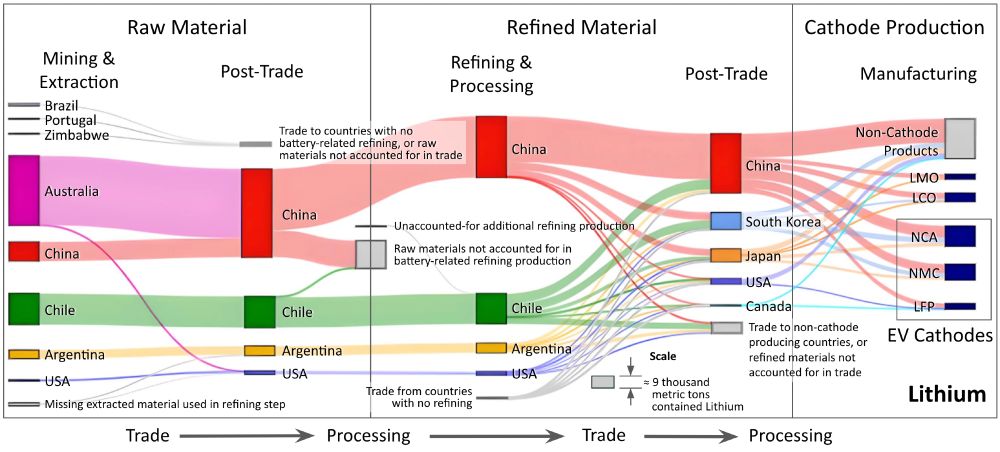
October 2, 2024 at 1:32 PM
Supply chains for critical EV battery materials, like Li, Co, Ni and Mn are vulnerable to disruptions. We quantified these vulnerabilities in Nature Communications earlier this year: nature.com/articles/s41...
Will the #IRA be enough to change this situation?
🧵2/14
Will the #IRA be enough to change this situation?
🧵2/14
Is the Inflation Reduction Act #IRA enough to reduce #EV battery supply chain vulnerabilities?
We investigate in our latest Nature Energy study: nature.com/articles/s41...
w/ Anthony Cheng & EricaFuchs
🧵1/14
We investigate in our latest Nature Energy study: nature.com/articles/s41...
w/ Anthony Cheng & EricaFuchs
🧵1/14

October 2, 2024 at 1:31 PM
Is the Inflation Reduction Act #IRA enough to reduce #EV battery supply chain vulnerabilities?
We investigate in our latest Nature Energy study: nature.com/articles/s41...
w/ Anthony Cheng & EricaFuchs
🧵1/14
We investigate in our latest Nature Energy study: nature.com/articles/s41...
w/ Anthony Cheng & EricaFuchs
🧵1/14
Carnegie Mellon is hiring in #AI and #PublicPolicy!
The Department of Engineering & Public Policy is hiring in the AI/policy space. Our specialty is policy-relevant questions for which the technical details matter.
Join us!
apply.interfolio.com/154855
The Department of Engineering & Public Policy is hiring in the AI/policy space. Our specialty is policy-relevant questions for which the technical details matter.
Join us!
apply.interfolio.com/154855

October 2, 2024 at 1:24 PM
Carnegie Mellon is hiring in #AI and #PublicPolicy!
The Department of Engineering & Public Policy is hiring in the AI/policy space. Our specialty is policy-relevant questions for which the technical details matter.
Join us!
apply.interfolio.com/154855
The Department of Engineering & Public Policy is hiring in the AI/policy space. Our specialty is policy-relevant questions for which the technical details matter.
Join us!
apply.interfolio.com/154855
Carnegie Mellon is hiring tenure-track faculty in AI & public policy!
apply.interfolio.com/154855
ChatGPT renders the position as such:
apply.interfolio.com/154855
ChatGPT renders the position as such:

September 25, 2024 at 8:44 PM
Carnegie Mellon is hiring tenure-track faculty in AI & public policy!
apply.interfolio.com/154855
ChatGPT renders the position as such:
apply.interfolio.com/154855
ChatGPT renders the position as such:


